What Are The Different Types Of Animals
An introduction to the different types of animals that make upward the creature kingdom Animalia.
Download the Gratuitous accompanying question sail to test your beast knowledge!
Page Alphabetize
Apply the links below to find the information you lot demand (or keep reading for a complete overview of the animal kingdom).
- Download the Gratuitous question sheet
- Unlike Types of Animals: Introduction
- Animalia: The Creature Kingdom
- The Two 'Main' Types of Animals: Invertebrates and Vertebrates
- Basic Animal Nomenclature
- Types of Invertebrate
- Sponges
- Flatworms
- Major types of flatworm
- Roundworms / Nematodes
- Cnidarians
- Major types of cnidarian
- Mollusks
- Notable Types Of Mollusk
- Arthropods
- Insects
- Notable Types Of Insect
- Crustaceans
- Notable Types Of Crustacean
- Arachnids
- Notable Types Of Arachnid
- Types of Vertebrate
- Fish
- Notable Fish Groups
- Amphibians
- Major Types Of Amphibian
- Reptiles
- Major Types Of Reptile
- Birds
- Notable Types Of Bird
- Mammals
- Major Mammal Groups
- Related Pages On Active Wild
Gratuitous Animals Question Sheet For Use With This Folio

Click here or on the prototype above to view / download a complimentary printable question sheet for utilize with this page. (PDF file, 1.two Mb). If the question sheet opens in your browser rather than downloading, right-click on the question sail and select 'download'.
Different Types Of Animals: Introduction
On this folio is a list of the main types of animals. Rather than looking at individual species such as 'tiger' or 'monarch butterfly', this is a list of the major groups of animals.
- If y'all want information on hundreds of individual species, including 'tiger' and 'monarch butterfly', then check out this page: A To Z Animals With Pictures & Facts
First nosotros accept a await at the two main types of brute: invertebrates and vertebrates. We then await at smaller groups within these larger groups.
For each blazon of fauna, you'll find links to more information about even smaller groups and notable species within each group.
This folio is an overview of the main types of animals; in that location are many other animal groups, both living and extinct!
We hope you relish this exploration of the animal kingdom. If you have any questions then feel gratis to ask in the comments department at the foot of the page.
Animalia: The Fauna Kingdom

An organism is a living affair. If nosotros recall of every single organism on Globe being part of one big group, then that grouping tin can be separate into smaller groups of organisms that are more than like each other than they are to other organisms.
Animalia – the animal kingdom – is ane of several large groups of living things.
Animals have a detail prepare of characteristics that separates them from other organisms such as plants, fungi and bacteria.
Other kingdoms include Plantae – the constitute kingdom, and Fungi, the kingdom that contains organisms such as mushrooms and molds.
Characteristics of animals include: being multicellular (i.e. they consist of more than i cell); existence able to motility (for at to the lowest degree role of their lives); animate oxygen; reproducing sexually; and existence unable to produce their own food (i.due east. they can't get energy from sunlight).
The animal kingdom is divided into many smaller groups. On this page we will take a wait at some of the different types of animals and their characteristics. We'll concentrate on the main animal groups, but will likewise have a look at a number of notable smaller animal types.
Different Types Of Animals
The Two 'Primary' Types of Animals: Invertebrates and Vertebrates
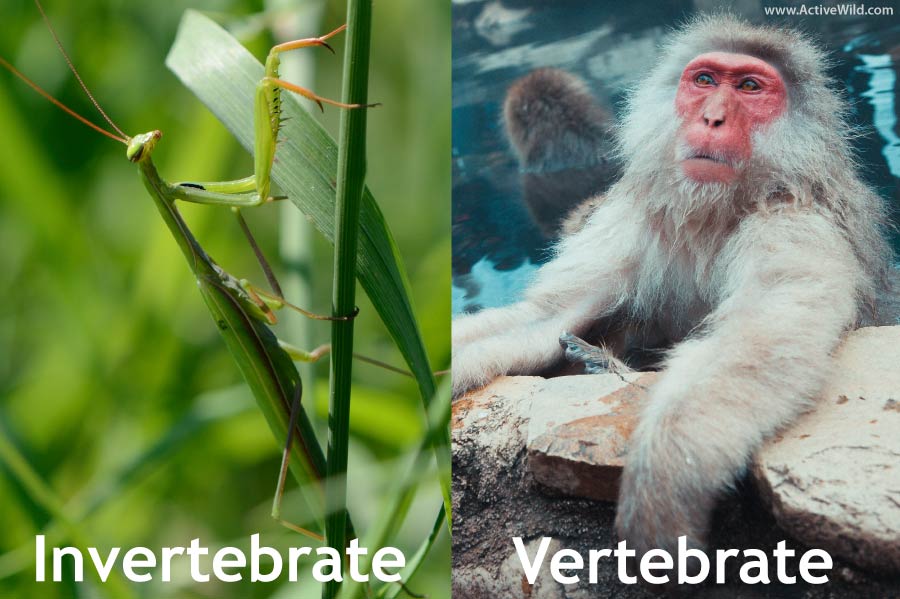
There are 2 primary types of brute: invertebrates and vertebrates. Invertebrates are animals that don't have a backbone; vertebrates are animals that do.
Of the 1.iv million or and so known fauna species, effectually 95% (or more than) are invertebrates. Of these, almost one million are insects.
Simply around 5% of known animals are chordates (chordates are animals that either have a backbone, or a similar structure known as a notochord).
Unlike vertebrates, invertebrates don't actually form a single group of related animals. In fact, some invertebrates are more closely related to vertebrates than they are to other invertebrates.
Although the word 'invertebrates' isn't an 'official' animal grouping, it does course a useful distinction between two very different types of animals. Because of this, we've separated the creature groups on this page into invertebrates and vertebrates.
Animal Classification Basics
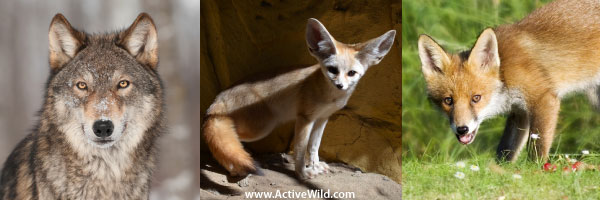
A 'kingdom' such every bit the animal kingdom or the plant kingdom consists of groups of organisms that share certain characteristics.
A kingdom can itself be divided into smaller groups of organisms that are more closely-related to each other than they are to other organisms.
Each of these smaller groups can and then be further divided into even smaller groups of organisms that are even more closely-related. This continues until we go right down to individual species.
(In fact, fifty-fifty an individual species can get divided into smaller groups, called subspecies. The canis familiaris, for example, is a subspecies of grey wolf.)
The science of placing species into groups is known as taxonomy. Each taxonomic stage, or 'rank' has its ain proper noun. From kingdom to species, the bones taxonomic ranks are: kingdom, phylum, class, order, family and species.
- You can detect out more than nigh animate being nomenclature on this folio: Animal Classification
Types of Animals: Invertebrates
Beneath is a selection of the major types of invertebrates.
Sponges

- Phylum: Porifera
Looking like bulbous, hollow plants, sponges are amidst the most basic of all animals. They lack a nervous organization and a tummy, and most species are capable of movement only in their juvenile form.
There are betwixt half dozen,000 and 9,000 known species of sponge (as with many areas of taxonomy, there is a smashing deal of discrepancy betwixt data on the exact number of sponges). Nearly all sponges are institute in marine habitats, although at that place are a small number of freshwater sponges.
Sponges are filter feeders. Inside a sponge'southward body are cells with whip-like projections called flagella. The motion of the flagella causes water to move through the sponge. The sponge feeds on microorganisms contained within the water.
One of the first scientists to realize that sponges were animals rather than plants was Aristotle.
Back to page index
Flatworms

- Phylum: Platyhelminthes
The species in the phylum Platyhelminthes are also known as flatworms. These invertebrate animals range in size from microscopic species to tapeworms that tin be up to 25m (82 ft.) in length.
Flatworms lack a torso crenel, and have neither a circulatory nor a respiratory system. They are the simplest animals to exhibit 'bilateral symmetry' (i.due east. to have bodies that are symmetrical). Flatworms accept existed for hundreds of millions of years and were the first carnivorous hunters.
Many living flatworms are parasitic. They make their way into a host organism and feed on its torso from the inside. This can be harmful and fifty-fifty deadly to the host brute.
Often the eggs of parasitic flatworms are eaten by a small animate being, in whose torso the flatworm undergoes the outset stage of its development. When the smaller host brute is eaten by a larger animal, the flatworm sets up a permanent home in its new host. Information technology feeds off the host fauna and likewise lays its eggs in the host's body. These are passed by the host fauna and the wheel begins over again.
Some flatworms brand their way through more than than one host before embedding themselves in their final host.
Major types of flatworm:
- Class Turbellaria – complimentary-moving, non-parasitic flatworms
- Form Cestoda – tapeworms and related species, all parasitic
- Clade Trematoda – flukes, all parasitic
- Class Monogenea – parasites that live infest the outside of a host species' body
Back to folio index
Roundworms / Nematodes
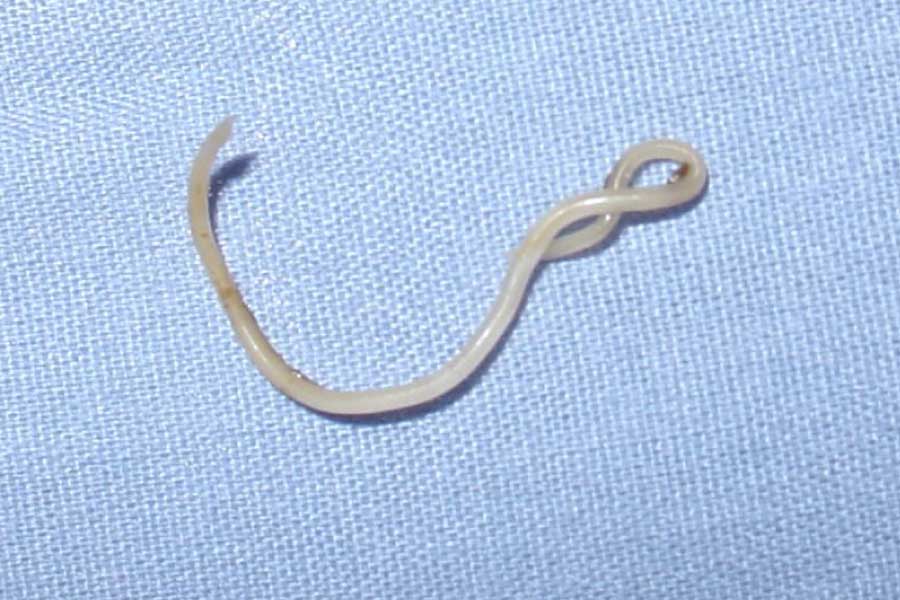
- Phylum: Nematoda
Roundworms have long, cylindrical bodies. While most are microscopic, some can reach lengths of 13m (42.6ft.). Around three,500 roundworm species are currently recognized, but some biologists believe that the actual number of species is closer to 40,000 or more.
One of the largest roundworms is Placentonema gigantissima. It is a parasite that lives in the placenta of a sperm whale.
Dissimilar flatworms, who use the same opening both to accept in food and to expel waste, roundworms have a more developed digestive system which has separate openings for each task.
There are very few ecosystems on Earth in which roundworms are not present. These adjustable animals are found in polar, mountainous, tundra and desert regions and well every bit undercover and on the sea bed.
There are more individual roundworms than any other type of animate being. It is estimated that there are 5 billion roundworms in every acre of fertile garden soil; 60 billion roundworms for each living person; and that roundworms account for 80% of all living animals.
Back to folio alphabetize
Cnidarians
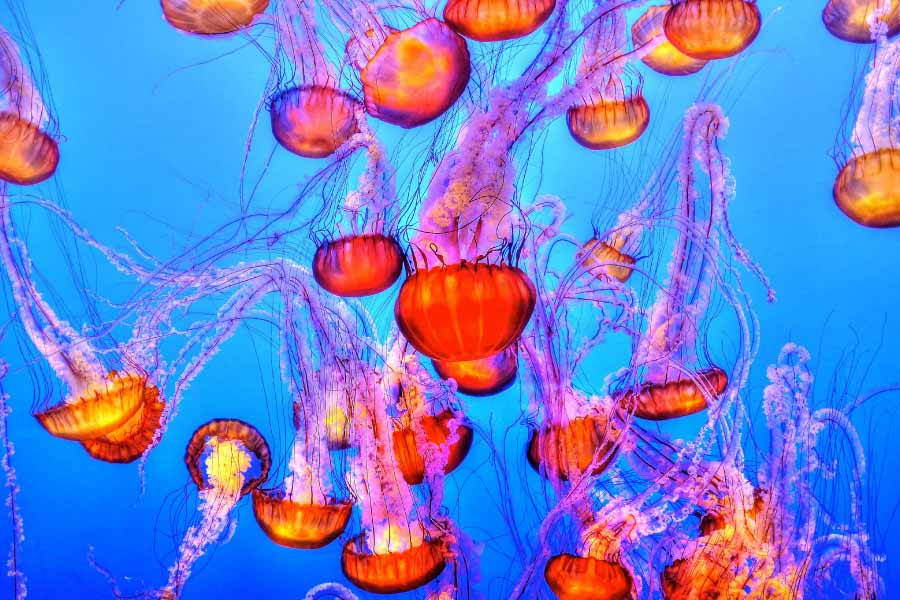
- Phylum: Cnidaria
The phylum Cnidaria includes animals such as corals, body of water anemones and jellyfish. They accept soft bodies with radial symmetry (i.eastward. they are symmetrical around a central indicate, with no 'back' or 'front' side).
Cnidarians such every bit corals and sea anemones permanently attach themselves to underwater surfaces after a short free-swimming larval stage. Others, such as jellyfish and the Portuguese man o' state of war, are free-swimming fifty-fifty in adulthood.
All cnidarians are carnivores. They are equipped with cells called cnidocytes, which deploy venom via a infinitesimal spear-similar structure. Cnidocytes are adapted for capturing prey, and for defense against predators. It is these cells that are responsible for a jellyfish's painful sting.
Major Types of Cnidarian
- Class Anthozoa (sea anemones and corals)
- Class Scyphozoa (jellyfish)
- Class Cubozoa (box jellyfish)
- Class Hydrozoa (a group of related animals that includes colonial species such every bit the Portuguese man o' war)
Back to page index
Mollusks
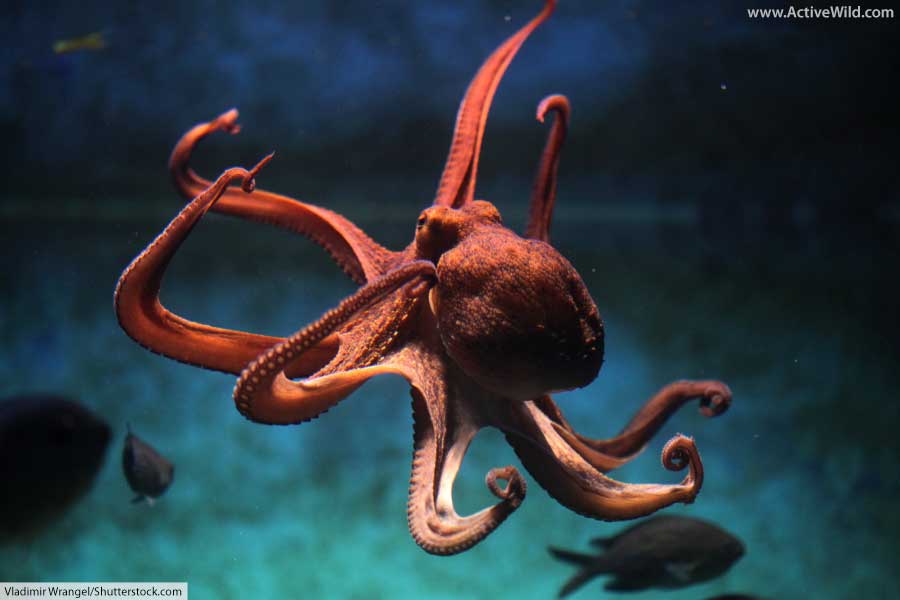
- Phylum: Mollusca
The phylum Mollusca, whose members are known every bit mollusks (spelt molluscs in British English), contains both the largest and the most intelligent invertebrates. This group contains animals as diverse as oysters and octopuses.
The Catalogue of Life (link) currently lists 65,442 species of mollusk, although other estimates suggest that effectually 85 thousand species are recognized.
Bivalves such as oysters and clams, gastropods such as snails and slugs, and cephalopods such every bit octopuses, squid and cuttlefish are all mollusks.
All mollusks accept a mantle, which is a thick muscular wall that contains respiratory and other organs. In cephalopods, the mantle also functions as a jet, which pushes the animal through the water.
The colossal squid is the largest living mollusk. It reaches an estimated length of effectually 14 m (46 ft.) and is constitute in the Antarctic ocean.
Octopuses are the most intelligent invertebrates. They have been observed using tools, solving bug and fifty-fifty playing – a behavior associated with intelligence.
Notable Types Of Mollusk
- Class Bivalvia – bivalves (oysters, clams, cockles, mussels and related species)
- Class Gastropoda – gastropods (slugs and snails)
- Class Cephalopoda – cephalopods (squid, cuttlefish, octopuses)
Back to page index
Arthropods
- Phylum: Arthropoda
Arthropods are a huge and diverse group of animals. There are over a million known species in the phylum Arthropoda, which contains all insects, crustaceans, arachnids, horseshoe crabs and myriapods (centipedes & millipedes) also as several other invertebrate groups.
The proper noun 'arthropod' means 'jointed foot'. All arthropods have segmented bodies, paired jointed appendages (i.eastward. legs, antennae, etc.) and hard exoskeletons.
Below nosotros await in more than detail at some notable arthropod groups.
Back to page index
Insects
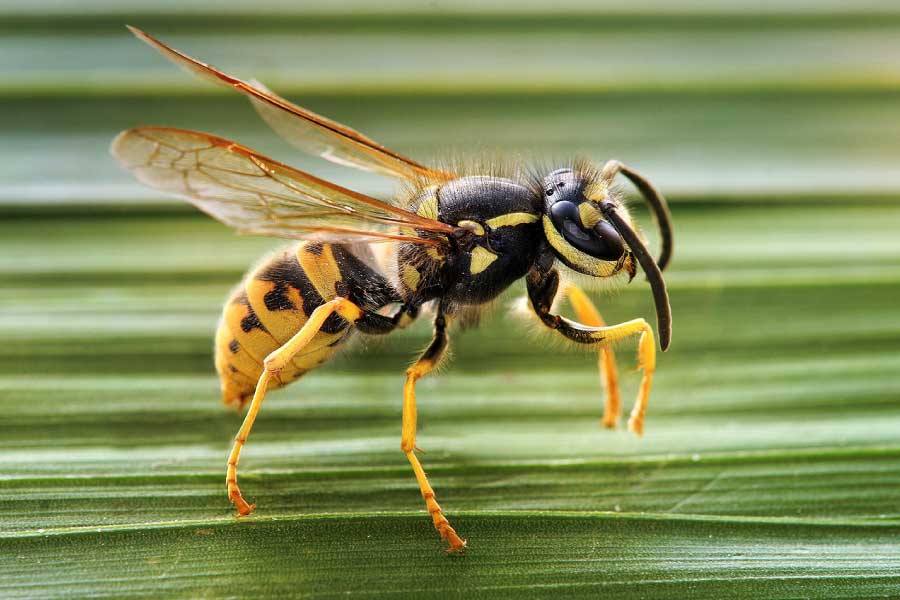
- Form: Insecta
Insects are idea to take appeared during the Silurian Period, betwixt 443.8–419.2 million years agone. (That's over 200 million years before dinosaurs!)
The kickoff known insect is Rhyniognatha hirsti, which resembled a mod-day silverfish and walked the Earth 396 million years ago.
Today insects are past far the largest single group of animals in terms of number of species. Over 1 meg insect species have been described (i.eastward. named and scientifically accustomed as being an individual species).
There are more than 3 times known insect species than there are known found species. Insects make up more than half of all known organisms.
In short, there are a lot of different types of insects!
Characteristics of all insects include: a hard exoskeleton, a body comprising three parts: caput, thorax and abdomen, 3 pairs of jointed legs, a single pair of antennae and a pair of chemical compound eyes.
The largest group (in terms of number of species) within Insecta is Coleoptera – the beetles. At that place are over 320,000 recognized species of beetle.
The earth's largest insect is the larval phase of the Goliath beetle Goliathus goliatus. The giant weta Deinacrida heteracantha – a giant, flightless cricket found in New Zealand – vies with the elephant beetles and Goliath beetles for the championship of heaviest developed insect.
The globe's smallest insect is the parasitic wasp Dicopomorpha echmepterygis, which is plant in the United States.
Notable Types Of Insect
- Order Coleoptera – beetles
- Order Diptera – flies
- Order Hymenoptera – wasps, bees and ants
- Order Mantodea – mantises
- Lodge Lepidoptera – collywobbles and moths
- Order Blattodea – cockroaches and termites
- Order Odonata – dragonflies
Detect More
- Yous can notice out more most insects on this folio: Insects: The Ultimate Guide
Back to page alphabetize
Crustaceans
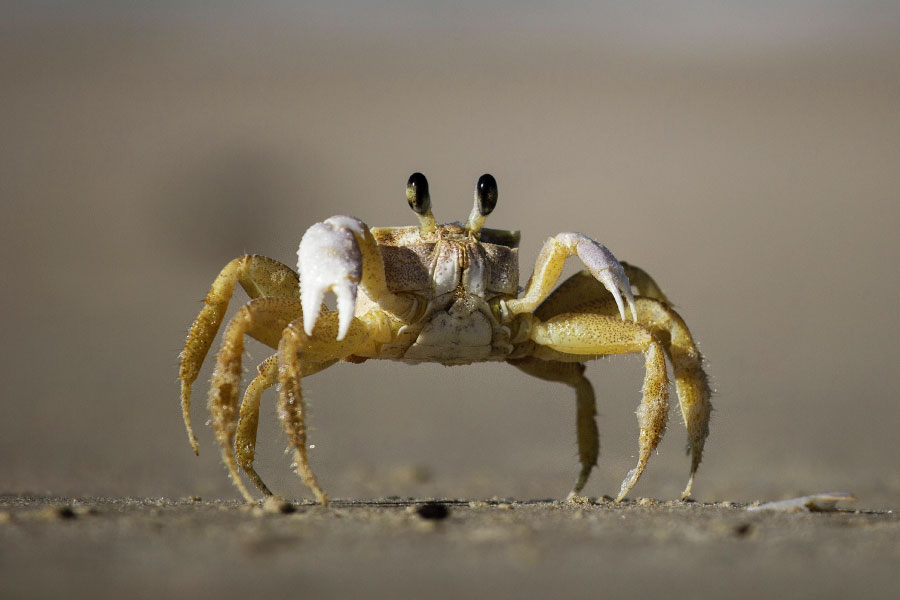
- Subphylum: Crustacea
With around 67,000 species, Crustacea is one of the largest arthropod groups. Crustaceans are extremely varied; the group includes crabs, lobsters, shrimps, krill, woodlice and barnacles. Nigh crustaceans alive in water, but some – including woodlice – are found on state.
Typical crustacean characteristics include a segmented torso with a difficult exoskeleton, ii pairs of antennae and a pair of chemical compound eyes, which are oftentimes mounted on stalks.
A characteristic of crustaceans not seen in other arthropods is the presence of 'biramous limbs'. These are limbs that branch into two. A crustacean's second pair of antennae may also exist biramous.
The world's smallest crustacean is the tiny marine parasite Tantulacus dieteri, which has a body length of 85 micrometers (0.0033 in). This miniature crustacean, which infests other small marine crustaceans, may be the earth's smallest arthropod. (Some mites of class Arachnida are equally every bit tiny.)
The largest crustacean is the Japanese spider crab, which has a maximum hook to claw length of 5.v meters (18 ft.).
The heaviest crustacean is the American lobster, Homarus americanus. With a mass of over xx kg (44 lb.), it is also the world'south heaviest arthropod.
Notable Types Of Crustacean
- Lodge Euphausiacea – krill
- Infraorder Brachyura – crabs
- Suborder Oniscidea – woodlice
- Infraorder Astacidea – lobsters, crayfish and related animals
- Infraclass Cirripedia – barnacles
Discover More
- You can find out more about crustaceans on this page: Crustaceans: The Ultimate Guide
Dorsum to page index
Arachnids
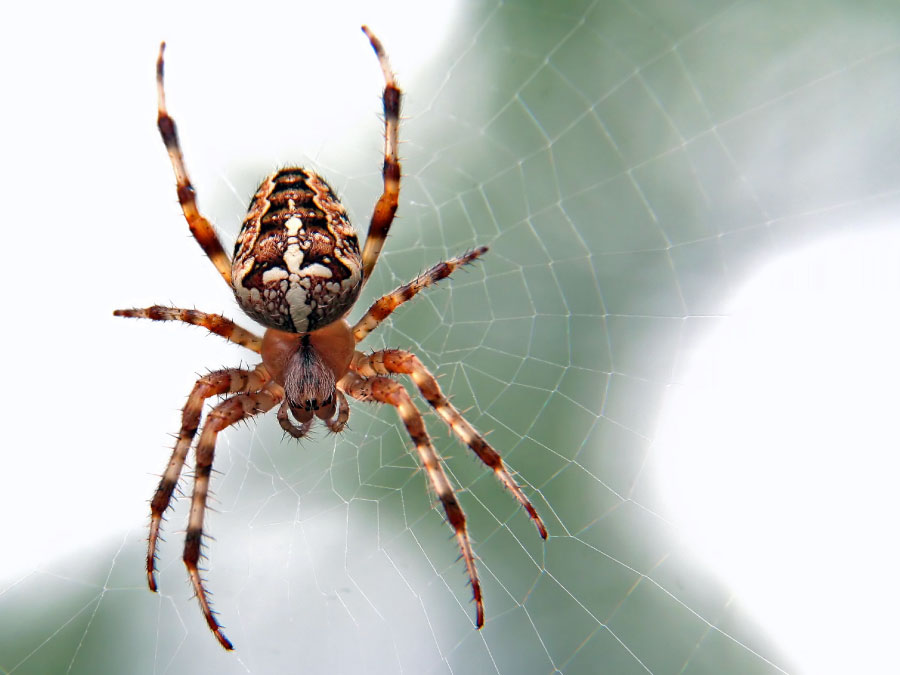
- Class: Arachnida
The best-known arachnids are spiders, simply this arthropod group as well includes scorpions, camel spiders, mites, ticks and other types of animals.
Arachnids have 4 pairs of legs, and a further ii pairs of appendages positioned near the oral cavity.
These additional appendages have a number of different uses depending on the species. The pair closest to the mouth are known as chelicerae. These are the arachnid'southward 'jaws'. A spider's chelicerae are hollow and are used to inject venom.
The second pair of appendages are known every bit 'pedipalps'. A spider'due south pedipalps are antennae-like sense organs, and besides play a part in reproduction. A scorpion'southward pedipalps accept adapted into pincers for manipulating prey.
Spiders are the largest arachnid group, with effectually 48,000 recognized species.
Notable Types Of Arachnid
- Bracket Acari – mites and ticks
- Club Opiliones – harvestmen / daddy longlegs
- Order Solifugae – camel spiders / wind scorpions / solifuges
- Order Araneae – spiders
- Order Scorpiones – scorpions
Observe More
- Y'all can observe out more than about arachnids on this page: Arachnids: The Ultimate Guide
Back to page index
Types of Animals: Vertebrates
A vertebrate is an animal with a courage.
We're vertebrates; if yous rub your back you'll probably be able to feel your courage. Having a courage is something nosotros share not only with our closest relatives in the fauna kingdom (the apes) but with every bird, reptile, mammal, amphibian and fish.
Unlike the invertebrates, vertebrates are function of a recognized biological group: the subphylum Vertebrata. (A subphylum is a subgroup of a phylum; Vertebrata is part of the phylum Chordata.)
This means that every animal with a backbone shares the same ancestor. Fish were the first animals to develop backbones, and so in the family tree of every vertebrate (including humans) is a fish!
Fish

- Superclass Osteichthyes (bony fish)
- Course Chondrichthyes (cartilaginous fish)
The first fish appeared in the Cambrian Period, around 500 million years ago. They were the first vertebrates, and the ancestors of all other vertebrates. Somewhere manner back in your ain family tree is a fish!
Notation: in biological science, the discussion 'fish' applies to a unmarried fish, or a group of the same species of fish. The word 'fishes' is used for a group of fish that contains multiple species.
Today there are ii master fish groups: the bony fishes (Osteichthyes) and the cartilaginous fishes (Chondrichthyes).
There are too two other, smaller, fish groups: the hagfish (class Myxini) and the lampreys (society Petromyzontiformes). These final 2 groups form a subgroup of Vertebrata known as the 'jawless fishes'.
Bony fish, every bit the proper name suggests, have skeletons made of bone. There are two main types of bony fish: the Actinopterygii, or ray-finned fishes, and the Sarcopterygii, or lobe-finned fishes.
The ray-finned fishes, with over 32,000 known species, business relationship for the vast majority of living fish. Their fins are sparse and supported by spiny bones. Most ray-finned fish have swim-bladders. These gas-filled sacs regulate buoyancy.
The fins of lobe-finned fish are fleshy, and extend from the body on brusque stalks. Lobe-finned fish are the ancestors of all non-fish vertebrates, including mammals.
Very few living species of lobe-finned fish remain. Those that do include the coelacanths and the lungfish.
Cartilaginous fish include the sharks, rays, skates and sawfish. Their skeletons are made non of bone, only of a natural substance called cartilage. The whale shark is not only the world'due south largest shark, but also the world's largest fish.
Notable Fish Groups
- Grade Actinopterygii – ray-finned fishes
- Course Sarcopterygii – lobe-finned fishes
- Bracket Elasmobranchii – (sharks, rays, skates, sawfish)
Back to folio index
Amphibians
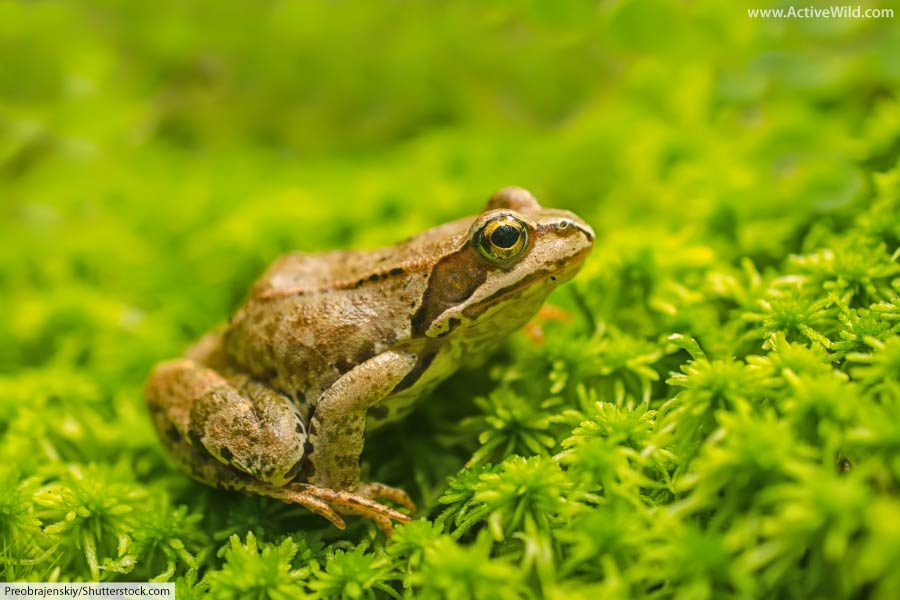
- Course Amphibia
Amphibians evolved from 4-footed animals known equally tetrapods, which themselves had evolved from lobe-finned fishes. (Another co-operative of tetrapods, Amniota, are the ancestors of all living reptiles, birds and mammals.)
The early on amphibians were the dominant animals on state. Big crocodile-like amphibians preyed on fish and other aquatic animals.
This changed when the amniotes evolved the ability to lay eggs on land. Once freed from their reliance on water for reproduction, early reptiles and the ancestors of mammals became the dominant state animals.
Today there are three master types of amphibians: the Anura (frogs and toads), Urodela (salamanders), and Apoda (caecilians).
Characteristics of amphibians include: eggs laid in h2o, an aquatic larval stage, moist pare capable of gas substitution, a terrestrial (country-home) adult phase. (Some amphibians have evolved ways of fugitive the larval phase and give nascence to live young. Others retain their gills and remain aquatic fifty-fifty in adulthood.)
Major Types Of Amphibian
- Order Anura (frogs and toads)
- Order Urodela (salamanders)
- Order Apoda (caecilians)
Detect More
- You can observe out more about amphibians on this page: Amphibians: The Ultimate Guide
Back to page index
Reptiles
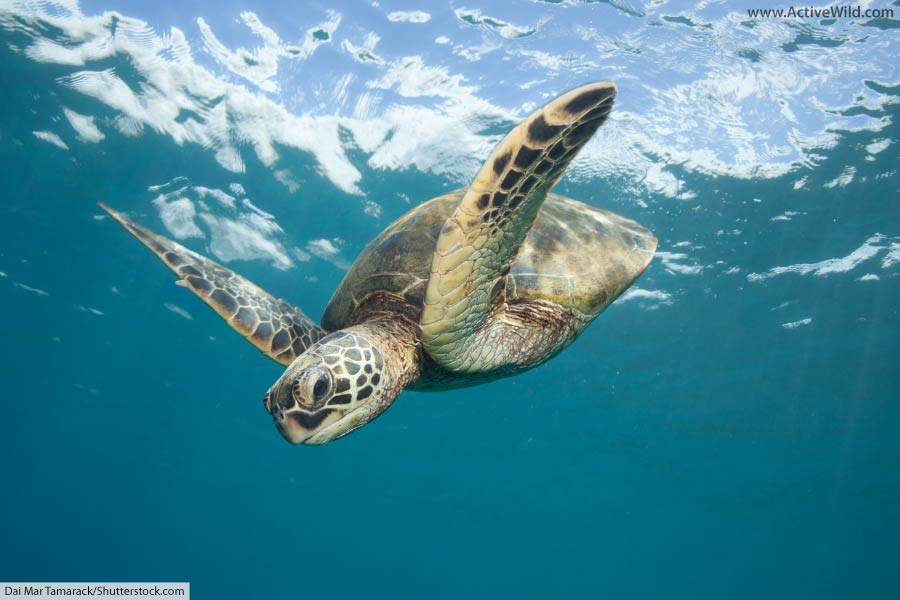
- Class Reptilia
Reptiles are cold-blooded animals that descended from a group of animals called tetrapods, which themselves had evolved from lobe-finned fish. Most reptiles lay eggs, only some requite birth to live immature.
During the Mesozoic Era reptiles became the dominant land animals, but their reign was concluded by the shooting star strike which caused the Cretaceous-Paleogene Extinction Event.
Living reptile groups include: Testudines (turtles and tortoises); Rhynchocephalia (the tuatara); Squamata (lizards and snakes); and Crocodilia (crocodiles, gavials, caimans, and alligators).
The world'due south largest reptile is the saltwater crocodile (Crocodylus porosus). Reaching lengths of upward to 6 m (xx ft.), this fearsome species is found in Australia and Southeast Asia.
There are simply over 10,000 known reptile species. By far the largest group of reptiles (in terms of number of the number of species it contains) is Squamata.
Some scientists consider birds to be reptiles equally they are the direct descendants of the dinosaurs. The inclusion of birds into Reptilia would roughly double the number of known reptiles.
Major Types Of Reptile
- Order Testudines (turtles and tortoises)
- Lodge Rhynchocephalia (the tuatara)
- Order Squamata (lizards and snakes)
- Order Crocodilia (crocodiles, gavials, caimans, and alligators)
Observe More
- You tin find out more about reptiles on this page: Reptiles: The Ultimate Guide
Back to page index
Birds
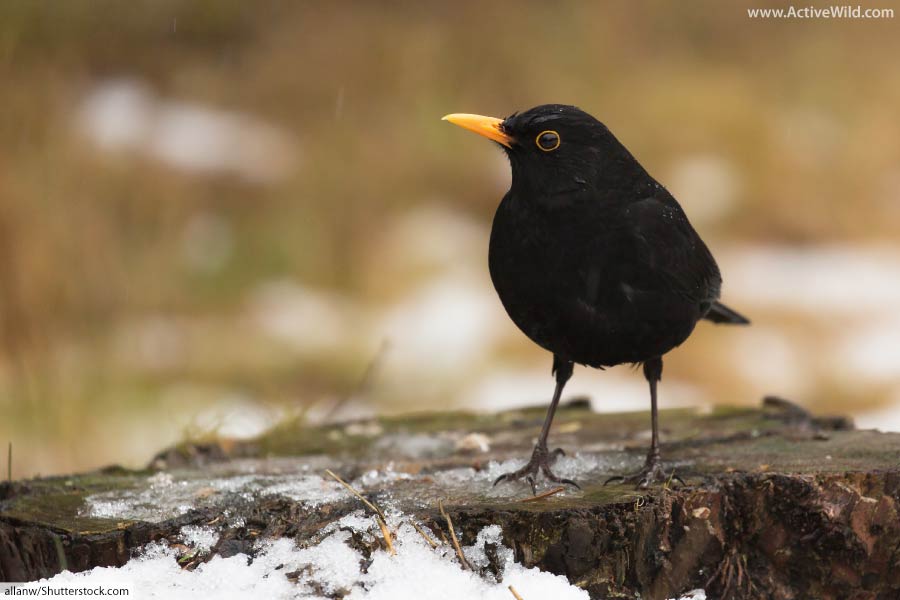
- Class Aves
Not all dinosaurs became extinct in the Cretaceous-Paleogene Extinction Result. Birds are directly descended from dinosaurs, and for this reason many scientists consider birds to exist dinosaurs.
Today, at that place are around 10,000 known bird species. They range in size from the tiny bee hummingbird to the common ostrich.
The vast majority of living birds belong to the infraclass Neognathae. Only sixty species vest to the other principal bird grouping, Palaeognathae. These include the tinamous of the Americas and the flightless kiwis, cassowaries, emu, rheas and ostriches.
Characteristics of mod birds include having feathers, toothless bills, forelimbs modified into wings, and laying eggs.
The get-go true birds appeared during the Cretaceous Period. During this time they would have shared the sky with the first flight vertebrates – the Pterosaurs.
Notable Types Of Bird
- Society Accipitriformes – birds of prey: hawks, eagles kites
- Lodge Anseriformes – waterfowl: ducks, geese, swans & related species
- Gild Charadriiformes – gulls, auks & waders
- Order Galliformes – gamefowl: turkeys, chickens, partridges, pheasants & related species
- Order Passeriformes – perching birds / songbirds
- Order Piciformes – woodpeckers
- Club Psittaciformes – parrots
- Social club Strigiformes – owls
Discover More
- You can notice out more about birds on this page: Birds: The Ultimate Guide
Back to page alphabetize
Mammals

- Class Mammalia
The offset truthful mammals first appeared during the Late Triassic, around 200 to 227 million years agone. While sharing Earth with the dinosaurs, the early mammals were by necessity small and nocturnal.
The Cretaceous-Paleogene Extinction Event spelt the end of the dinosaurs' reign. With the dinosaurs gone, mammals quickly became the dominant land animals. They evolved to fill many different niches, even returning to the sea in the shape of whales and dolphins.
Characteristics of mammals include: having hair, giving birth to live immature (only five species of mammal, the monotremes, lay eggs), being warm-blooded, breathing air with lungs, and having mammary glands.
In that location are three main types of mammal: monotremes (Monotremata), marsupials (Marsupialia), and placental mammals (Placentalia).
The monotremes, which consist of four species of echidna and the platypus, are the just living egg-laying mammals.
Marsupials are likewise known equally 'pouched mammals'. Their immature are born in a relatively undeveloped state. They undergo further evolution in a special pouch in the mother's body, where they have admission to milk.
Placental mammals requite birth to young at a later phase of development than marsupials. While in the womb a developing placental mammal is supplied with nutrients via an organ known as a placenta. The placenta also handles gas-exchange and removes waste products.
Major Mammal Groups
- Order Artiodactyla – even-toed ungulates: cattle, pigs, sheep, deer, antelopes, giraffes, camels, hippopotamuses and related species
- Infraorder Cetacea (part of Artiodactyla): whales, porpoises, dolphins
- Social club Carnivora: dogs, cats, seals, weasels, bears & related species
- Order Chiroptera: bats
- Order Diprotodontia: kangaroos, possums, wombats & related species
- Order Lagomorpha: rabbits, hares & related species
- Order Monotremata: echidnas, platypus
- Order Perissodactyla – odd-toed ungulates: horses, rhinoceroses, tapirs
- Gild Primates: lemurs, galagoes, monkeys, apes & related species
- Order Rodentia: rodents
Observe More
- You tin can find out more than nigh mammals on this page: Mammals: The Ultimate Guide
Back to folio index
Types of Animals: Conclusion
We hope that you've enjoyed this overview of the animal kingdom and meeting many different types of animals. If you have any questions so experience costless to enquire them in the comments section at the foot of the page.
Discover More With Active Wild
Continue your exploration of Animalia by visiting the pages below:
- Animals: The Ultimate Guide To The Animal Kingdom
- Amphibians: The Ultimate Guide
- Reptiles: The Ultimate Guide
- Birds: The Ultimate Guide
- Mammals: The Ultimate Guide
- A to Z Animals With Pictures & Facts
Source: https://www.activewild.com/types-of-animals/
Posted by: stewartfaturaved.blogspot.com

0 Response to "What Are The Different Types Of Animals"
Post a Comment